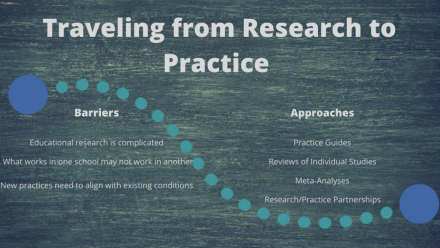Bridging the Gap
As a school leader, asking teachers to use the most current research in their classrooms is like asking them to swim across the Atlantic Ocean because the continent on the other side is beautiful. Although many of your teachers may agree with you in theory, they may not know where to start or how to get there without drowning in the deep.
Of course, any journey is easier when the route is well established. For instance, research on how young children develop reading skills is an area with a solid research foundation. However, what about research on helping students learn vocabulary for reading in chemistry classes? This area feels more like an uncharted adventure. For middle and high school educators in particular, being asked to apply research to practice can be overwhelming, if not downright intimidating. In this post, we discuss some of the barriers that prevent teachers from applying research to practice and what resources you, as an instructional leader, can use to bridge the gap.
Barrier: Educational research is complicated
Education is complex. On any given day, there are factors that influence student motivation, attention, and engagement. This makes the work of research hard (and important). Let us say that we want to know which strategy is the most effective at supporting skilled argumentation. We can randomly assign Crystal to prepare for the “rebuttal battle” and Keon to prepare for the “argumentation organizer.” What we do not know is that Crystal had a fight with her sister just before class and that Keon had been debating a similar topic with his uncle the day before. These factors swamp the relatively small effect of the difference in our debate preparation strategy. This is one of the challenges facing educational researchers: to distinguish small average effects in the face of the buzzing complexity of school life.
Researchers use a range of approaches to “control for” the variability across classes and students. The general logic here is that if we randomize many students to each condition, the “breakups” and “debate prep” kids will balance out across groups. In this case, we can be more confident in attributing the differences in argumentation to the effectiveness of one of the debate preparation strategies (relative to the other). However, interpreting individual studies requires careful reading and usually some statistical knowledge. It is not enough to understand the research findings. To make wise decisions, instructional leaders and teachers are expected to ask questions such as the following:
- Are the research claims supported with sufficient and relevant evidence?
- Are the conclusions drawn by researchers reasonable?
It takes time to think deeply about research and connect the findings to our own experiences as teachers and learners.
Barrier: What works in one school may not work in another
Even when they have a clear understanding of research, educators still need to determine if the findings from one particular educational setting are applicable to their school or classroom community. Studies are always conducted in a particular set of schools or with a particular sample of students; findings cannot always be generalized across student populations. Similarly, the effects across sites in clustered randomized trials are heterogeneous, meaning that some school profiles benefit more than others (Lawrence et al., 2017). It takes careful research and reading to interpret these heterogeneous effects (Raudenbush & Schwartz, 2020).
Barrier: New practices need to align with existing conditions
Teaching teams often tweak, adapt, append, and integrate practices (Correnti et al., 2020; Fogo et al., 2019). For a teacher or teaching team to adopt and adapt a practice, they need to understand the general implications of practice rather than just the “effect size” of a particular program. For example, there might be research that shows a particular program that helps students learn academic vocabulary. The school schedule precludes the adoption of the entire program, but there are features of the curriculum that the social studies team wants to use to enhance the existing seventh-grade civic debate project. To do so, they need to both understand the relevant research and have the time to apply these findings to the conditions in practice while still being able to reflect on the implementation as they launch the new aspects of the program. Implementing research-based practices in schools requires careful planning to ensure we do not compromise the things that are already working. We, as leaders, need to support connections to existing practices whenever possible. When we fail to do so, teachers begin to lose confidence that any particular practice is “here to stay.”
These are serious challenges, but before throwing in the towel on implementing research-based practices, we should remember that people cross the Atlantic Ocean all the time. They do not swim, though; instead, they travel by boat or plane. So what are the travel options for teachers to get from practice to research and back again? There are many approaches that can help teachers narrow the gap, but we will focus on four of them: reviews of studies, meta-analyses, practice guides, and research–practice partnerships.
Approach: Reviews of individual studies
The Institute for Education Science (IES) provides robust funding for randomized trials to evaluate specific interventions using rigorous methods. In fact, one of the difficulties of bringing research-based methods into the classroom is the sheer volume of existing research of this kind! There are organizations that have recognized this issue and have committed to sorting through the research for educators. One of the more well-known resources is the What Works Clearinghouse (WWCH), which is supported by IES. The WWCH website aims to qualify and condense current research into reviews that are easier for educators to use. Unfortunately, these reviews do not focus on contextual factors (like financial and other costs) that are important to school leaders.
Approach: Meta-analyses
Meta-analyses draw conclusions about a topic from the information presented in many studies on related topics. In theory, meta-analyses can help bridge the gap between research and practice by presenting educators with broad strokes so that they do not have to dig through dense research themselves. John Hattie is probably the best-known author of this kind of work (Hattie, 2013). However, as our colleagues Arne Lervåg and Monica Melby-Lervåg point out in their post on Hattie, there are some shortcomings to his work and to meta-analyses in general. Primarily, we should not draw instructional conclusions from correlational results. Even when meta-analyses are done well, this sort of study does not provide the contextual details that will be relevant for a teacher or team of teachers trying to implement an instructional idea.
Approach: Practice guides
Practice guides are probably the most popular bridge between research and classroom practice. Practice guides synthesize research in a way that gives digestible suggestions for classroom practice. One of the best-known practice guides for adolescent literacy was commissioned by the Institute of Education Sciences (Kamil et al., 2008). This guide highlights five strategies, as follows:
- Provide explicit vocabulary instruction
- Provide direct and explicit comprehension strategies
- Provide opportunities for extended discussion of text meaning and interpretation
- Increase student motivation and engagement in literacy learning
- Make available intensive and individualized interventions for struggling readers that can be provided by trained specialists
This is probably the most influential practice guide for secondary literacy instruction, but at this point, it is out of date. Reynolds (2020) points out that this guide does not highlight themes like close reading, academic language, or multiple-text comprehension, all of which are central to current research about adolescent literacy development. He also notes that at the time the guide was written, the quality of the research available on many important topics was limited. Suffice to say, it is a mistake to limit professional learning to practice guides, but they do have a role, especially when read alongside reviews like those offered by Dr. Reynolds.
Approach: Research–practice partnerships
Imagine a group of researchers collaborating side by side with teachers in a school district to design curricula and conduct research that will directly inform practice. This tight coupling of research and practice is the aim of research–practice partnerships. A model for this kind of partnership is called the Strategic Education Research Partnership (SERP; National Research Council, 2004). Josh participated in SERP work at a Boston field site while doing his doctorate and completing his postdoctoral fellowship. One of the resulting projects from SERP is the freely available Word Generation curriculum.
One of the goals of this model, as originally conceived, was to develop partnerships that would not be reliant on the funding cycles of the major research agencies. The idea was that states and districts could contribute a portion of their budgets to supporting the institute, which would demonstrate its value to its collaborators. The model would allow researchers and educators to think of and answer tough questions without worrying about a four-year window for completing a study (this is the normal timeline for IES-funded studies). It is not clear whether these funding mechanisms are feasible. SERP has been incredibly successful in generating knowledge and creating (fantastic) resources for schools, but it has done so through traditional research and philanthropic funding sources, usually in a partnership with larger districts.
Reading Ways is trying to develop another model for research/practice partnerships. We bring together researchers and practitioners in our networks and work directly with schools to connect research with specific practices. We use our OASIS coaching model to support teachers and coaches as they test and reflect on research-based practice and connect their experiences to the research we discuss together. Our model allows us to collaborate with districts of all sizes. We believe that as we scale up, we will come to make important knowledge contributions not only to our networks and partner schools, but also to the scientific community.
Final Remarks: Is It Worth It?
We have seen the importance of using research to inform practice and the pitfalls of failing to do so. We believe that using peer-reviewed research should be a component of a data-driven decision-making process that we use to support literacy in our schools. Here, we have found that the most important aspect of using research to inform instruction is the discussion and debate that it can engender among our staff. A strategy that is not implemented strategically is not a strategy; it is just a worksheet. It does not matter if that strategy has a research base behind it. Our teachers are skilled professionals, and they need the time to digest and test research findings. When they do so, research can become an important resource for our school communities.
References
Correnti, R., Matsumura, L. C., Walsh, M., Zook‐Howell, D., Bickel, D. D., & Yu, B. (2020). Effects of online content‐Focused coaching on discussion quality and reading achievement: Building theory for how coaching develops teachers’ adaptive expertise. In Reading Research Quarterly.
Fogo, B., Reisman, A., & Breakstone, J. (2019). Teacher adaptation of document-based history curricula: Results of the Reading Like a Historian curriculum-use survey. Journal of Curriculum Studies, 51(1), 62–83.
Hattie, J. (2013). Visible learning: A synthesis of over 800 meta-analyses relating to achievement. Routledge.
Kamil, M. L., Borman, G. D., Dole, J., Kral, C. C., Salinger, T., & Torgesen, J. (2008). Improving adolescent literacy: Effective classroom and intervention practices. IES practice guide. NCEE 2008-4027. National Center for Education Evaluation and Regional Assistance, 65.
Lawrence, J. F., Francis, D., Paré-Blagoev, J., & Snow, C. E. (2017). The poor get richer: Heterogeneity in the efficacy of a school-level intervention for academic language. Journal of Research on Educational Effectiveness, 10(4), 767–793.
National Research Council. (2004). Learning and instruction: A SERP research agenda. The National Academies Press.
Raudenbush, S. W., & Schwartz, D. (2020). Randomized experiments in education, with implications for multilevel causal inference.
Reynolds, D. (2020). Of research reviews and practice guides: Translating rapidly growing research on adolescent literacy into updated practice recommendations. Reading Research Quarterly, 31, 46.

